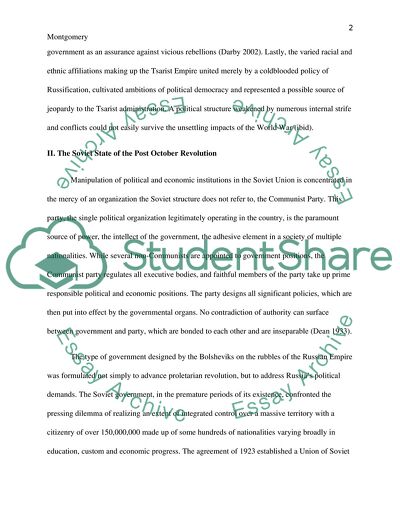
- Home
- Free Samples
- Premium Essays
- Editing Services
- Extra Tools
- Essay Writing Help
- About Us
- Studentshare
- Subjects
- Miscellaneous
- The Civil War and War Communism in Russia from October Rev to end of 1920
The Civil War and War Communism in Russia from October Rev to end of 1920 - Essay Example

- Subject: Miscellaneous
- Type: Essay
- Level: Ph.D.
- Pages: 4 (1000 words)
- Downloads: 0
- Author: browndomenica
Extract of sample "The Civil War and War Communism in Russia from October Rev to end of 1920"
The peasants, who achieved their freedom in 1861, had acquired inadequate allotments of arable land, and for the greater part had fell short to improve the value of private ownership which defines the conservative peasant class in Western nations; determined revolutionists, they intolerantly awaited the time when they might seize the landlords (ibid). Neither had Russia created a well built conservative middle class which might have functioned as a fortress against the evils of the revolution.
The lower bourgeoisie and scholars had been resisting against the monarchy and the Orthodox Church, and consistently endeavored in radical movements aimed at the setting up of political democracy. An intellectual few renowned for their accomplishments in arts and science failed to alleviate the population of a society which was 60 per cent uneducated and whose illiteracy was considered by the government as an assurance against vicious rebellions (Darby 2002). Lastly, the varied racial and ethnic affiliations making up the Tsarist Empire united merely by a coldblooded policy of Russification, cultivated ambitions of political democracy and represented a possible source of jeopardy to the Tsarist administration.
A political structure weakened by numerous internal strife and conflicts could not easily survive the unsettling impacts of the World War (ibid). Manipulation of political and economic institutions in the Soviet Union is concentrated in the mercy of an organization the Soviet structure does not refer to, the Communist Party. This party, the single political organization legitimately operating in the country, is the paramount source of power, the intellect of the government, the adhesive element in a society of multiple nationalities.
While several non-Communists are appointed to government positions, the Communist party regulates all executive bodies, and faithful members of the party take up
...Download file to see next pages Read MoreCHECK THESE SAMPLES OF The Civil War and War Communism in Russia from October Rev to end of 1920
Joseph Stalin
Life and Accomplishments of Joseph Stalin
The reality of the 1920s in the US
Russia 1917-1941. Rise of Nazism in Germany, World War II
Major Issues on a Red Scare Phenomenon
Russia in the 20th Century
Russian Revolution Civil War
Dissolution of the Russian Constituent Assembly, 19 January 1918

- TERMS & CONDITIONS
- PRIVACY POLICY
- COOKIES POLICY